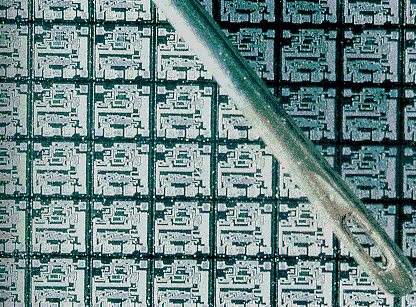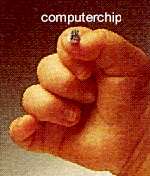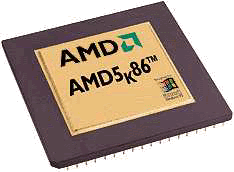THE PRESENT - COMPUTERS AS WE KNOW THEM
Personal computers were made possible by two technical innovations in the field of microelectronics:-
![]() the integrated circuit, 1958
the integrated circuit, 1958
![]() and
the microprocessor, which first appeared in 1971
and
the microprocessor, which first appeared in 1971
Move mouse cursor over the picture below, of a modern day integrated circuit, to see one of the first IC's ever made. .
Developed, in part, by Jack Kilby, Texas Instruments, 1958, Nobel Laureate in Physics 2000, it was fabricated on a single piece of Germanium (approximately 5 x 11 mm) with protruding wires and glued to a glass slide.
A microprocessor – also known as a CPU or central processing unit – is a complete computation engine that it fabricated on a single chip. The first microprocessor was the Intel 4004, introduced in 1971. The 4004 was not very powerful – all it could do was addition and subtraction, and it could only do that 4 bits at a time. Although, what was amazing at this time, was the fact that everything was on one chip
There are three very basic features of a microprocessor:-
![]() It can perform mathematical operations like addition,
subtraction, multiplication and division. Modern microprocessors can perform
extremely sophisticated operations on large floating point numbers.
It can perform mathematical operations like addition,
subtraction, multiplication and division. Modern microprocessors can perform
extremely sophisticated operations on large floating point numbers.
![]() It can move data from one memory location to another.
It can move data from one memory location to another.
![]() It can make decisions and jump to a new set of
instructions based on those decisions.
It can make decisions and jump to a new set of
instructions based on those decisions.
Generally this is a small, thin piece of silicon onto which the transistors making up the microprocessor have been etched. A chip might be as large as an inch square and can contain tens of millions of transistors. Simpler processors might consist of a few thousand transistors etched onto a wafer of silicon just a few millimetres square. The below pictures show how small modern day silicon chips can be.



As manufacturing processes and materials advance the sheer number of transistors that can be etched onto a silicon chip rapidly increases in accordance with Moore’s Law. However THE FUTURE has in store much more than “x” number of transistors...